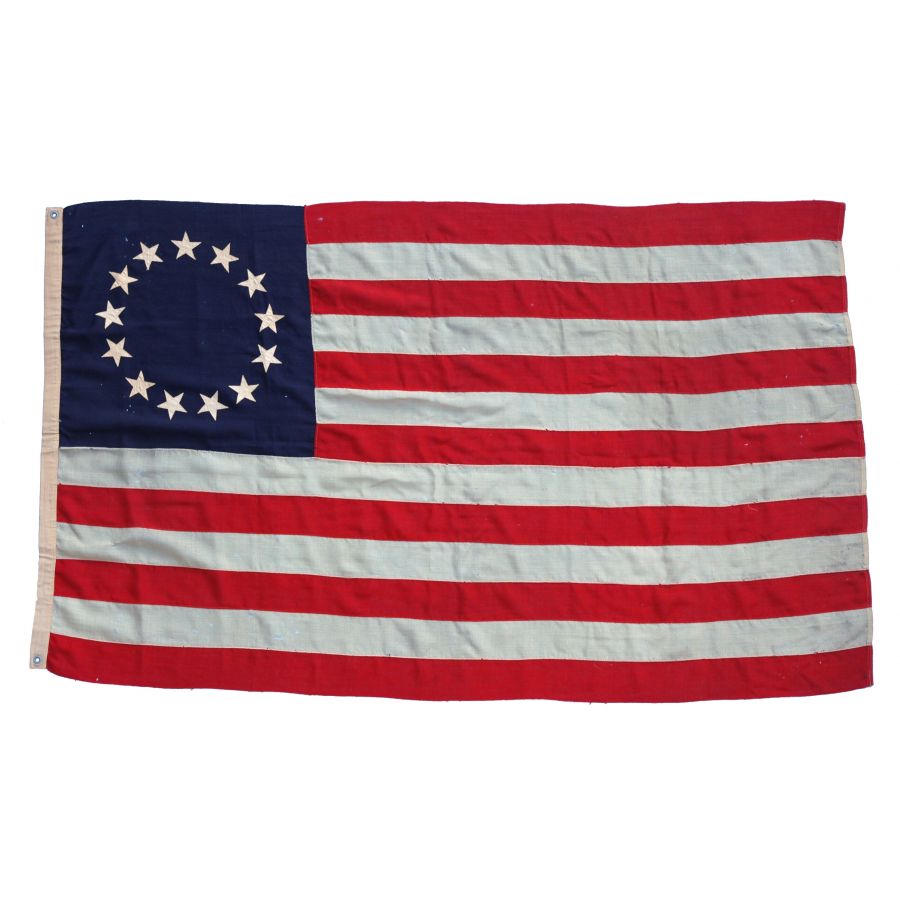
| |
13 STARS, BETSY ROSS PATTERN, AMERICAN FLAG COMPANY, NEW YORK & CHICAGO, RARE LARGE SIZE, EXHIBITED AT WINTERTHUR MUSEUM |
|
| Available: |
Sold |
| Frame Size (H x L): |
|
| Flag Size (H x L): |
46" x 82" |
|
| Description....: |
|
13 STARS, BETSY ROSS PATTERN, AMERICAN FLAG COMPANY, NEW YORK & CHICAGO, RARE LARGE SIZE, EXHIBITED AT WINTERTHUR MUSEUM:
13 star American national flag with Betsy Ross-style wreath configuration. This is a particularly beautiful flag in an unusually large size. Note the tall and narrow canton which does not coincide with modern proportions. A label along the hoist reads: "AMERICAN FLAG COMPANY, Manufacturers, New York - Chicago". The American Flag Company was in business as early as the 1876 centennial of our nation's independence and possibly prior. This particular flag was probably made between the Spanish-American War (1898) and the Sesquicentennial of our nation's independence (150th anniversary) in 1926. The presence of this particular label is quite rare and examples of Betsy Ross pattern flags that are longer than five feet on the fly, like this one, are practically never encountered. High quality flags in this style with especially strong graphic qualities are likewise rare. It is for this reason that the Henry Francis du Pont Winterthur Museum chose to borrow it to welcome visitors to a landmark exhibit on Betsy Ross.
Many people do not understand the scarcity of 13 star flags with a circular wreath of 13 stars in early America. While we are taught in grammar school that this was what our first flag looked like, there is no hard evidence to prove the claim, which is widely accepted as myth among flag enthusiasts. Of the very few Colonial examples that exist, none have survived with this star configuration. Further, while thousands of 13 star flags were made during the during the 19th century, for all manner of patriotic purpose, almost none have survived with this pattern that were made prior to the last decade of the 19th century.
Research conducted by the National Museum of American History notes that the story of Betsy Ross making the very first American flag for General George Washington entered into American consciousness about the time of the 1876 centennial celebrations. The tale was immensely popular among an American public eager for stories about the revolution and its heroes. The first written documentation of it appeared in a paper written for the Pennsylvania Historical Society by her grandson, William Canby, just shortly beforehand in 1870. At this time Canby made no mention of how the flag was designed, save for the fact that it had 5-pointed stars per his grandmother's suggestion.
Though on rare occasion circles of 13 stars appear in early American imagery, the pattern basically does not appear on actual flags until the period between approximately 1898 to 1913, when Betsy Ross' granddaughter (Rachel Albright) and great grand daughter (Sarah M. Wilson) operated a cottage industry in the East Wing of Independence Hall in Philadelphia, making hand-sewn flags for tourists. Rachael and Sarah proudly proclaimed that their flags, which had a circle of 13 stars, replicated the original, which they likewise reported was designed and made by their mother. Sadly, neither Canby's nor Albright and Wilson's claims are supported by facts.
Because the first American national flag does not survive and no period accounts of it exist, no one actually knows what its star configuration looked like, but it is widely accepted among flag enthusiasts that it did not have a circle of 13 stars. In fact, the Betsy Ross pattern didn't become became common until the mid 20th century. By the 1976 Bicentennial it was produced in great quantity and today remains the most recognizable style. The longstanding popularity of the myth solidified into legend.
13 star flags have been used throughout our nation's history for a variety of purposes. The U.S. Navy used the 13 star count on small boats, not only in the 18th century, but throughout much or all of the 19th century, particularly the second half. The practice ended in 1916 following an executive order from President Woodrow Wilson. Some private ships also used 13 star flags during the same period as the Navy, and the use of yachting ensigns with a wreath of 13 stars surrounding an anchor, which began in 1848, still persists today. Among other uses, 13 star flags were carried by soldiers during the Mexican and Civil Wars, and were used at patriotic events, including Lafayette's visit in 1825-26, the celebration of the nation's Centennial in 1876, and the Sesquicentennial in 1926.
Construction: The canton and stripes of the flag are made of wool bunting that has been joined by machine. The cotton stars are double-appliquéd (applied to both sides) with a zigzag stitch. This method was patented in 1892 and was the most common method of applying stars from about 1895 through WWII (U.S. involvement 1941-45). There is a twill cotton sleeve with two brass grommets.
Provenance: The flag was exhibited during “Betsy Ross: The Life behind the Legend”, Winterthur Museum, Delaware, October 2nd, 2010 —January 2nd, 2011.
Monting: The flag has not yet been mounted.
Condition: There is minor mothing but there are no serious condition issues. |
|
|
|
| Collector Level: |
Intermediate-Level Collectors and Special Gifts |
|
| Flag Type: |
Sewn flag |
|
| Star Count: |
13 |
|
| Earliest Date of Origin: |
1898 |
|
| Latest Date of Origin: |
1926 |
|
| State/Affiliation: |
13 Original Colonies |
|
| War Association: |
|
|
| Price: |
SOLD |
|
| |
Views: 5629 |
|
|
|

